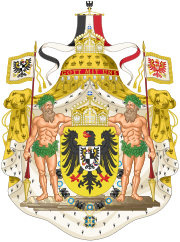Prince Henry of Prussia (1900–1904)
This article needs additional citations for verification. (July 2013) |
| Prince Henry of Prussia | |
|---|---|
Evangelical Christian |
| Prussian Royalty |
| House of Hohenzollern |
|---|
 |
| Frederick III |
|
Prince Henry Victor Louis Frederick of Prussia (
Life
Prince Heinrich was born on 9 January 1900, in Kiel. His father was pleased by the birth of yet another son, especially such a handsome one, as the Prince had blonde hair.[citation needed] The newborn Prince immediately received the title Prince of Prussia with the style Royal Highness, and was baptised Heinrich Viktor Ludwig Friedrich in Kiel Castle on 15 March 1900.[1] His older brothers were Prince Waldemar, a namesake of his uncle, and Prince Sigismund, a namesake of his other deceased uncle. Heinrich was named in honour of his father. The Prince was diagnosed with haemophilia as a young child, but, despite this, was a very cheerful and lively boy who liked to play a lot. As Henry grew older he became more aware of his condition.
Death
On 25 February,
Aftermath
Prince Heinrich's premature death would later very much affect the Princess, who would withdraw into herself. One of his older brothers, Prince Waldemar, also had haemophilia. He lived up to the age of 56 and was married, without children. The middle sibling, Prince Sigismund, was unaffected by the disease.
Ancestry
| Ancestors of Prince Henry of Prussia (1900–1904) | ||||||||||||||||||||||||||||||||||||||||||||||||||||||||||||||
|---|---|---|---|---|---|---|---|---|---|---|---|---|---|---|---|---|---|---|---|---|---|---|---|---|---|---|---|---|---|---|---|---|---|---|---|---|---|---|---|---|---|---|---|---|---|---|---|---|---|---|---|---|---|---|---|---|---|---|---|---|---|---|
| ||||||||||||||||||||||||||||||||||||||||||||||||||||||||||||||
Notes
- ^ "Court Circular". The Times. No. 36091. London. 16 March 1900. p. 6.
Legend: X – unaffected X chromosome; x – affected X chromosome; Y – Y chromosome; ? - unknown carrier status
Source: Aronova-Tiuntseva, Yelena; Herreid, Clyde Freeman (20 September 2003). "Hemophilia: 'The Royal Disease'" (PDF). SciLinks. National Science Teachers Association. p. 7. Archived from the original (PDF) on 10 January 2018. | |||||||||||||||||||||||||||||||||||||||||||||||||||||||||||||||||||||||||||||||||||||||||||||||||||||||||||||||||||||||||||||||||||||||||||||||||||||||||||||||||||||||||||||||||||||||||||||||||||||||||||||||||||||||||||||||||||||||||||||||||||||||||||||||||||||||||||||||||||||||||||||||||||||||||||||||||||||||||||||||||||||||||||||||||||||||||||||||||||||||||||||||||||||||||||||||||||||||||||||||||||||||||||||||||||||||||||||||||||||||||||||||||||||||||||||||||||||||||||||||||||||||||||||||||||||||||||||||||||||||||||||||||||||||||||||||||||||||||||||||||||||||||||||||||||||||||||||||||||||||||||||||||||||||||||||||||||||||||||||||||||||||||||||||||||||||||||||||||||||||||||||||||||||||||||||||||||||||||||||||||||||||||||||||||||||||||||||||||||||||||||||||||||||||||||||||||||||||||||||||||||||||||||||||||||||||||||||||||||||||||||||||||||||||||||||||||||||||||||||||||||||||||||||||||||||||||||||||||||||||||||||||||||||||||||||||||||||||||||||||||||||||||||||||||||||||||||||||||||||||
